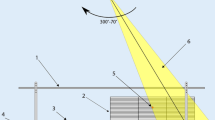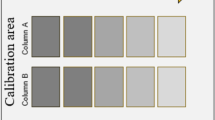Abstract
An important characteristic of kilovoltage therapy is the narrow penumbra obtainable with a well designed collimator system. A graphical illustration of applicator geometry is used to show that undesirable penumbral broadening and consequent reduction of field coverage could result if the upper aperture in an applicator is smaller than a critical size or if the applicator is not sufficiently well aligned with the focal spot. This concept is applied in an investigation of the formation of penumbra in the Gulmay D3300, in which the influence of the focal spot size, shape and emission profile, obtained from an image of the focal spot produced using a pin-hole in a sheet of lead, is elucidated. The effective focal spot of the Varian X-ray tube was observed to be rectangular, significantly longer in the front–back direction (6 mm) than in the anode–cathode direction (3.5 mm) and quite non-uniform in emission intensity over its length, with pronounced hot-spots at each end. It is shown that this results in a penumbra which is slightly broadened in the front–back direction when the alignment is perfect, but significantly broadened asymmetrically even when the alignment just meets the manufacturer’s stated tolerance. Consequently the alignment, which is performed with an alignment jig supplied by the manufacturer, needs to be very precise to obtain acceptable field coverage, which needs to be checked following an X-ray tube change.








Similar content being viewed by others
References
Locke J, Karimpour S, Young G, Lockett MA, Perez CA (2001) Radiotherapy for epithelial skin cancer. Int J Radiat Oncol Biol Phys 51(3):748–755. doi:10.1016/S0360-3016(01)01656-X
Amdur RJ, Kalbaugh KJ, Ewald LM, Parsons JT, Mendenhall WM, Bova FJ, Million RR (1992) Radiation therapy for skin cancer near the eye: Kilovoltage X-rays versus electrons. Int J Radiat Oncol Biol Phys 23(4):769–779. doi:10.1016/0360-3016(92)90650-7
Lim JTW (1992) Irradiation of the pinna with superficial kilovoltage radiotherapy. Clin Oncol 4(4):236–239. doi:10.1016/S0936-6555(05)81059-3
Caccialanza M, Piccinno R, Moretti D, Rozza M (2003) Radiotherapy of carcinomas of the skin overlying the cartilage of the nose: results in 405 lesions. Eur J dermatol 13(5):462–465
Rodriguez JM, Deutsch GP (1992) The treatment of periocular basal cell carcinomas by radiotherapy. Br J Ophthalmol 76(4):195–197. doi:10.1136/bjo.76.4.195
Fitzpatrick PJ, Hompson GA, Easterbrook WM, Gallie BL, Payne DG (1984) Basal and squamous cell carcinoma of the eyelids and their treatment by radiotherapy. Int J Radiat Oncol Biol Phys 10(4):449–454. doi:10.1016/0360-3016(84)90023-3
Caccialanza M, Piccinno R, Percivalle S, Rozza M (2009) Radiotherapy of carcinomas of the skin overlying the cartilage of the nose: our experience in 671 lesions. J Eur Acad Dermatol Venereol 23(9):1044–1049. doi:10.1111/j.1468-3083.2009.03247.x
Lye JE, Butler DJ, Webb DV (2010) Enhanced epidermal dose caused by localized electron contamination from lead cutouts used in kilovoltage radiotherapy. Med Phys 37(8):3935–3939. doi:10.1118/1.3458722
Ali ESM, Rogers DWO (2008) Quantifying the effect of off-focal radiation on the output of kilovoltage X-ray systems. Med Phys 35(9):4149–4160. doi:10.1118/1.2966348
Hill R, Healy B, Holloway L, Baldock C (2007) An investigation of dose changes for therapeutic kilovoltage X-ray beams with underlying lead shielding. Med Phys 34(7):3045–3053. doi:10.1118/1.2748103
Austerlitz C, Mota H, Gay H, Campos D, Allison R, Sibata C (2008) On the need for quality assurance in superficial kilovoltage radiotherapy. Radiat Prot Dosim 130(4):476–481
Rosenschöld PMa, Nilsson P, Knöös T (2008) Kilovoltage X-ray dosimetry—an experimental comparison between different dosimetry protocols. Phys Med Biol 53(16):4431–4442
Wang D, Sobolewski M, Hill R (2012) The dosimetry of eye shields for kilovoltage X-ray beams. Australas Phys Eng Sci Med 35(4):491–495. doi:10.1007/s13246-012-0166-9
Li XA, Ma C-M, Salhani D, Agboola O (1998) Dosimetric evaluation of a widely used kilovoltage X-ray unit for endocavitary radiotherapy. Med Phys 25(8):1464–1471. doi:10.1118/1.598320
Butson MJ, Yu PKN, Cheung T, Oborn BM (2011) Effects of radiation scatter exposure on electrometer dose assessment in orthovoltage radiotherapy. Radiat Meas 46(4):436–439. doi:10.1016/j.radmeas.2011.01.008
Ismail M, Afzal M, Nadeem M, Rana AM, Amjad S, Buzdar SA (2011) Evaluation of depth dose characteristics of superficial X-rays machine using different kVp and applicators diameter. Int J Radiat Res 9(3):159–166
Chow JCL, Owrangi AM (2012) Surface dose reduction from bone interface in kilovoltage X-ray radiation therapy: a Monte Carlo study of photon spectra. J Appl Clin Med Phys 13(5):3911
Butson MJ, Cheung T, Yu PKN (2008) Measurement of dose reductions for superficial X-rays backscattered from bone interfaces. Phys Med Biol 53(17):N329
Butson MJ, Cheung T, Yu PKN, Price S, Bailey M (2008) Measurement of radiotherapy superficial X-ray dose under eye shields with radiochromic film. Phys Med 24(1):29–33. doi:10.1016/j.ejmp.2007.11.001
Medvedevas N, Adlienė D, Laurikaitienė J, Andrejaitis A (2011) The role of shielding in superficial X-ray therapy. Radiat Prot Dosim 147(1–2):291–295. doi:10.1093/rpd/ncr340
Khan FM (2010) The Physics of Radiation Therapy, 4th edn. Lippincott Williams & Wilkins, Philadelphia
Hendee WR, Ibbott GS, Hendee EG (2004) Radiation Therapy Physics, 3rd edn. Wiley, Hoboken
Mayles P, Nahum AE, Rosenwald JC (2007) Handbook of Radiotherapy Physics: Theory and Practice. Taylor & Francis Group, Boca Raton
Meredith WJ, Massey JB (1972) Fundamental Physics Of Radiology, 2nd edn. John Wright & Sons Ltd., Bristol
Young MEJ (1983) Radiological Physics, 3rd edn. H. K. Lewis & Co., Ltd., London
Mayles WPM, Lake R, McKenzie A, Macaulay EM, Morgan HM, Jordan TJ, Powley SK (eds) (1999) Physics Aspects of Quality Control in Radiotherapy (Report 81). IPEM, York
Evans PA, Moloney AJ, Mountford PJ (2001) Performance assessment of the Gulmay D3300 kilovoltage X-ray therapy unit. Br J Radiol 74(882):537–547
Williams JR, Thwaites DI (eds) (2000) Radiotherapy Physics. In Practice, 2nd edn. Oxford University Press, Oxford
Zhu XR, Yoo S, Jursinic PA, Grimm DF, Lopez F, Rownd JJ, Gillin MT (2003) Characteristics of sensitometric curves of radiographic films. Med Phys 30(5):912–919. doi:10.1118/1.1568979
Author information
Authors and Affiliations
Corresponding author
Appendix: Description and geometrical properties of the alignment jig
Appendix: Description and geometrical properties of the alignment jig
The jig simulates an applicator, having a top flange which incorporates a central pin-hole but is otherwise similar to the flanges on the clinical applicators. The jig also has a central radio-opaque cross-wire on the distal end. The pin-hole is midway between the focal spot and the cross-wire. By taking films with this jig in place, using short enough exposure times to avoid over-exposure within the images, it is possible to quantify the displacement of the focal spot from the central axis of the jig. By rotating the jig through 180° between films placed at its end, the effect of any significant imperfections in the geometry of the jig itself can be eliminated. On the two films the cross-wire image is displaced from the jig central axis location by equal amounts, but in opposite directions, so the mean position of the images in space coincides with the central axis. Since the cross-wire is in contact with the film, the position of its image on the film is not influenced by the position of the focal spot.
As is evident from the geometrical analysis below, the jig dimensions are such that the average (taken from the two films) displacement of the pin-hole image of the focal spot from the image of the cross-wire is equal and opposite to the displacement of the focal spot from the collimator axis. The manufacturer specifies a tolerance of 0.5 mm for the alignment. Any difference in the displacement of the focal spot image from the cross-wire image seen on the two films would indicate that either the pin-hole or the cross-wire is not on the jig rotation axis, but would not affect the determination of the focal spot displacement as described above. It is possible in principle to also quantify the extent (if any) to which the pin-hole and the cross-wire are individually displaced from the collimator rotation axis by superimposing on the one film two images taken with the jig rotated 180° between them. However it can be difficult to reposition the jig in precisely the same position relative to the film after rotating it and to interpret the resulting superimposed images.
Geometry of image formation with the alignment jig.
The length of the jig is equal to the distance from the focal spot to the upper face of the jig, so the pin-hole is half way between the focal spot and the film in contact with the end of the jig (Fig. 9).
Taking the intersection of the jig rotation axis with the film as the origin in each film, position of image of the focal spot in the first film is at:
Position of image of the focal spot in the second film is at:
Position of image of cross-wire in the first film is at \(z'_{1}\).
Position of the image of the cross-wire in the second film is at.
Therefore the displacement of the image of the focal spot from the image of the cross-wire in the first film.
The displacement of the image of the focal spot from the image of the cross-wires in the second film.
Therefore the average displacement of the image of the focal spot from the image of the cross-wire for both films.
Thus the average displacement of the image of the focal spot from the image of the cross-wire is equal and opposite to the displacement of the focal spot from the jig central axis.
The change in the displacement of the image of the focal spot from the image of the cross-wire between the two films.
Thus if the pin-hole and cross-wire both lie precisely on the jig central axis, the focal spot and cross-wire images will be in the same relative positions in both films.
Rights and permissions
About this article
Cite this article
Baldwin, Z., Fitchew, R. The influence of focal spot size, shape, emission profile and position on field coverage in a Gulmay D3300 Kilovoltage X-ray therapy unit. Australas Phys Eng Sci Med 37, 515–523 (2014). https://doi.org/10.1007/s13246-014-0280-y
Received:
Accepted:
Published:
Issue Date:
DOI: https://doi.org/10.1007/s13246-014-0280-y





